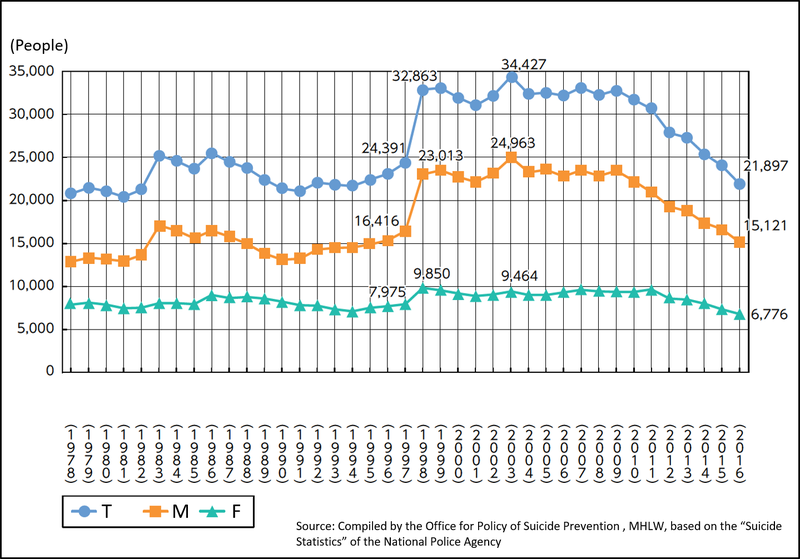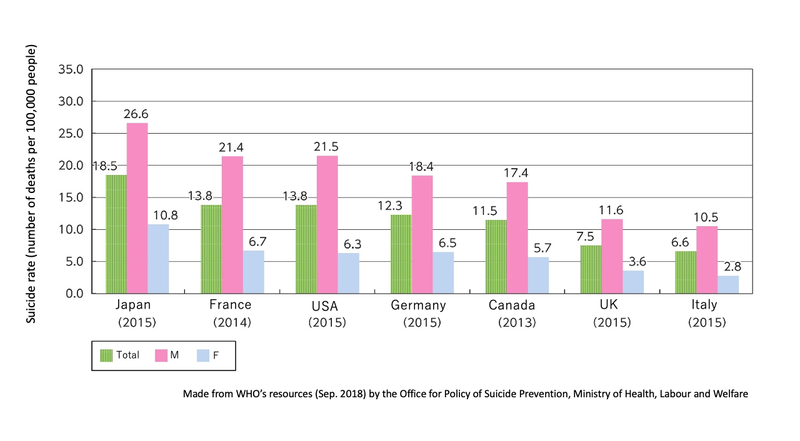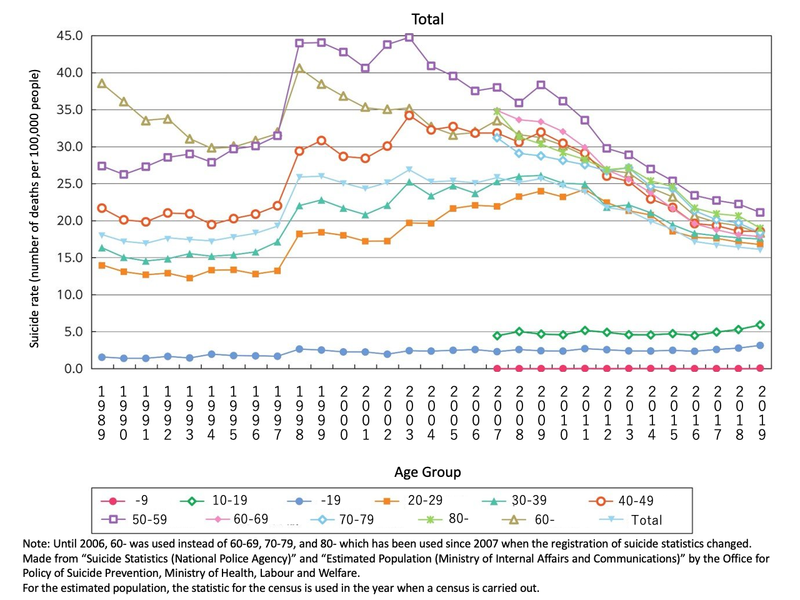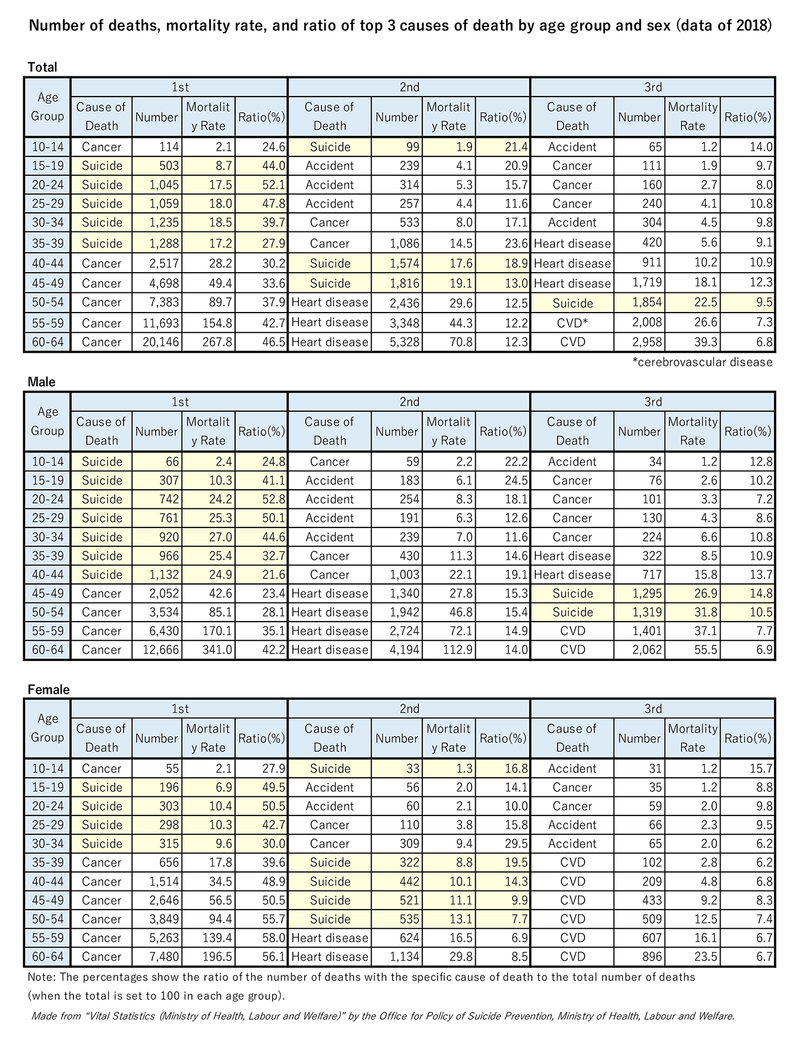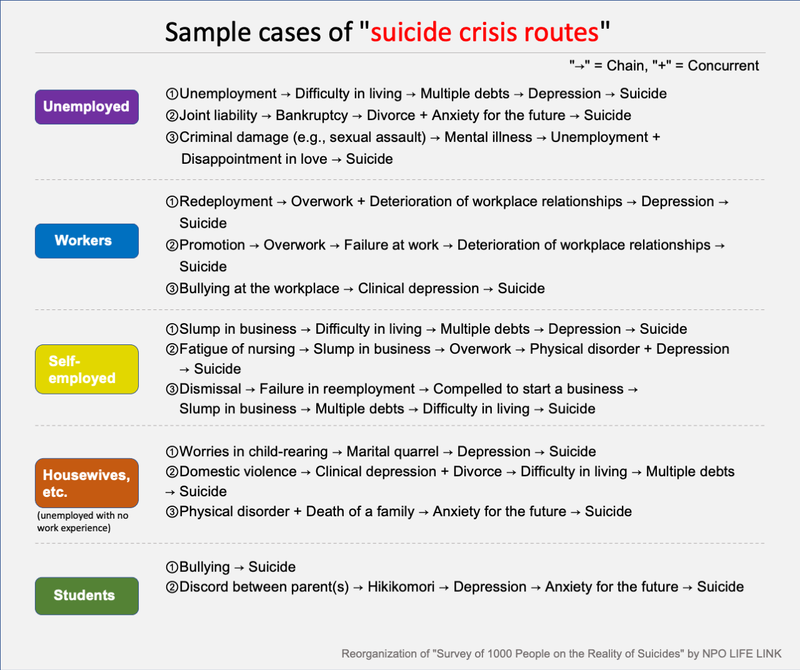

Outline of Suicide Countermeasures
Reality of Suicides
Most suicides are deaths to which have been driven. Suicide is not just a spur-of-the-moment act during which someone takes his/her own life; it must be understood as a process, one in which a person is forced into a situation where s/he feels compelled to do so. In its background are not just mental health issues; overwork, poverty, parental burnout and caregiver fatigue, bullying and social isolation and various other social factors are known to be involved; it is never a problem in certain people. As the World Health Organization (WHO) has clearly stated, suicide is a social problem that is largely preventable; it is becoming common knowledge throughout the world that suicides are deaths that can be prevented by the efforts of society.
Present situation of suicide in Japan
Changes in the number of suicides
The number of suicides dropped below 30,000 for the first time in 15 years in 2012, after remaining over 30,000 for 14 consecutive years since 1998. There has been a decline for 10 consecutive years since 2010, with 20,169 people in 2019 which was the lowest since records began in 1978. However, the situation remains serious as over 20,000 people still have taken their own lives. In 2020, when the COVID-19 pandemic had become serious, the number of suicides rose to 20,919 (preliminary value), 750 more than the previous year; this was the first to increase in 11 years.
Suicide rates among major countries
The suicide rate (number of suicides per 100,000 population) in Japan is the highest among 7 major developed countries.
Changes in the suicide rate by age group: particularly serious for the young generation
The suicide rate by age in Japan shows a substantial decrease among people in their 40s to 60s compared to the peak period. On the other hand, the number for under 20 years old has remained roughly flat, and the number for those in their 20s to 30s shows a decrease in recent years, though the rate of decrease is smaller than 40s to 60s.
According to the statistics of the causes of death by age group, the leading cause of death for each age group between 15 and 39 is suicide. By sex, suicide is the leading cause of death for males between the ages of 10 and 44, and for females between the ages of 15 and 34.
Reality of suicides
Most suicides are deaths to which have been driven
According to The General Principles of Suicide Prevention Policy which was established as a guideline for suicide countermeasures in Japan, “Most suicides are deaths to which have been driven.” It is known that suicide is caused by not only by mental health problems, but also many social factors such as overwork, destitution, fatigue of childcare and nursing, bullying and isolation.
In addition, suicide is not just a spur-of-the-moment act during which someone takes his/her own life; it must be understood as a process, one in which a person is forced into a situation where s/he feels compelled to do so. The mental state that leads to suicide can thus be seen as a process in which people are psychologically driven by various worries and fall into a state in which they believe there is no other choice but suicide, or one in which they are driven to a breaking point because of weakening ties to society, a role loss that makes life seem meaningless or a sense of the excessive onerousness of the role expected of them. A look at the mental state of persons just prior to being driven to suicidal behavior has clarified that the majority are psychologically driven by various worries; as a result, they are in a depressive state or have developed a mental illness such as depression or alcohol-dependency, under the influence of which they are incapable of exercising sound judgment.
Thus, suicide is not the result of individual choice or free will but can be described as a death to which many have been driven.
The process that leads people to die depending on their occupation and position such as unemployed or employed is known to have certain rules, as sort of a “pattern” when they are driven to suicide.
Most suicides are social issues that can be prevented
As shown above, suicide is not only a problem for certain people.
As WHO clearly states that most suicides are social issues that can be prevented, it has become a common understanding around the world that suicide is a death that can be avoided through the efforts of society.
Related New Topics
- November 28, 2025
- Call for papers : Suicide Policy Research (Volume 5, No. 1)
- September 18, 2025
- Suicide Policy Research
- January 21, 2025
- Innovative Research Program on Suicide Countermeasures: Final Report on Commissioned Research Results





